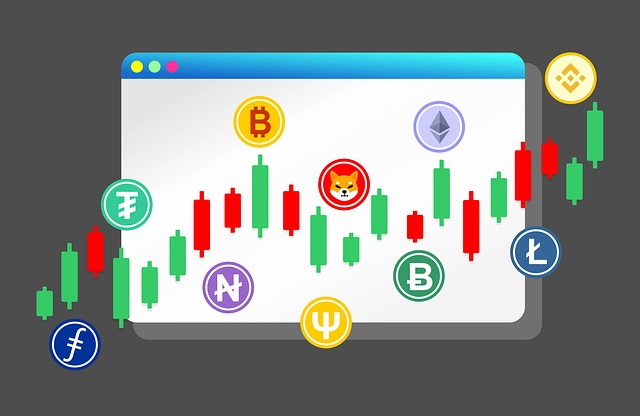Crypto Price Index and CPI Explained
Author: Jameson Richman Expert
Published On: 2025-09-13
Prepared by Jameson Richman and our team of experts with over a decade of experience in cryptocurrency and digital asset analysis. Learn more about us.
Understanding the intricate relationship between the crypto price index and the Consumer Price Index (CPI) is fundamental for a broad spectrum of market participants, including investors, policymakers, economists, and financial analysts. As cryptocurrencies transition from speculative assets to integral components of the global financial ecosystem, their market dynamics increasingly mirror macroeconomic variables—particularly inflationary trends, monetary policy shifts, and economic sentiment. This comprehensive exploration delves into the fundamental definitions of both indices, examines their complex interconnections, identifies key influencing factors, and discusses potential future implications. By exploring historical contexts, technological advancements, and policy impacts, readers will gain a nuanced perspective essential for informed decision-making amid today’s volatile and rapidly evolving financial landscape.

Overview of Crypto Price Index
The crypto price index acts as a vital gauge for assessing the overall health, sentiment, and performance of the digital asset market. Unlike traditional stock indices—such as the S&P 500 or Dow Jones Industrial Average—crypto indices are specifically designed to capture the unique attributes of cryptocurrencies, including their high volatility, rapidly evolving technology sectors, and liquidity profiles. These indices typically utilize weighted methodologies—such as market capitalization weighting, equal weighting, or liquidity-based weighting—to synthesize diverse asset movements into a comprehensive snapshot. Major platforms like CoinMarketCap, CryptoCompare, and CoinGecko constantly update live indices, reflecting real-time market fluctuations. Sector-specific crypto indices—focusing on niches like DeFi, NFTs, privacy coins, or layer-2 scaling solutions—offer granular insights, enabling investors to analyze sector performance, diversify strategies, and manage risks more effectively. The evolution of these indices, including the integration of derivatives and synthetic assets, continues to deepen market transparency and analytical precision.
Understanding Consumer Price Index (CPI)
The Consumer Price Index (CPI) is a core macroeconomic indicator that measures the average change over time in the prices paid by consumers for a fixed basket of goods and services. It serves as the primary gauge of inflation, directly affecting the purchasing power of fiat currencies and influencing macroeconomic policy decisions. The CPI basket encompasses categories such as housing (rent, owners' equivalent rent), transportation (fuel, vehicle prices), food, healthcare, education, entertainment, and apparel. Data collection involves extensive surveys, retail price tracking, and sampling across diverse geographic regions to ensure representativeness. Variations in CPI influence wage negotiations, social benefits, and investment decisions—particularly in inflation-linked securities. A rising CPI signals inflationary pressures that can erode real returns on investments and savings, prompting considerations for assets like commodities, real estate, and increasingly, cryptocurrencies as inflation hedges. Policymakers monitor CPI closely to calibrate monetary policy responses aimed at maintaining economic stability.
Relationship Between Crypto Price Index and CPI
The relationship between the crypto price index and CPI is characterized by complex feedback mechanisms, market perceptions, and macroeconomic signals. Cryptocurrencies—especially Bitcoin—are often described as “digital gold,” serving as a hedge against inflation. Empirical evidence suggests that during periods of rising CPI—indicating inflationary pressures—investor interest in digital assets tends to increase, driven by fears of fiat currency devaluation. Historical episodes, such as the inflationary turmoil of the 1970s or recent hyperinflation scenarios in emerging markets, have seen Bitcoin and other cryptocurrencies gain prominence as alternative stores of value. Conversely, during deflationary periods or when crypto markets decline, confidence in these assets may weaken, affecting their role as inflation hedges. Furthermore, systemic shocks—geopolitical conflicts, financial crises, or technological failures—can simultaneously exert upward or downward pressures on inflation and crypto volatility. This interplay highlights the importance of analyzing both indices together to gauge broader macroeconomic trends, investor sentiment, and systemic risks, enabling more nuanced market interpretations.

Factors Influencing the Crypto Price Index and CPI
Both the crypto price index and CPI are sensitive to a wide array of interconnected factors, which can produce amplifying or mitigating effects. For cryptocurrencies, key drivers include regulatory developments—such as bans, approvals, taxation, and compliance policies—as well as technological innovations like Ethereum 2.0 upgrades, layer-2 scaling solutions, and interoperability protocols. Market sentiment, often driven by news, institutional adoption, and macroeconomic cues, plays a vital role—positive developments can propel prices, while regulatory crackdowns induce sharp declines. Additionally, macro factors such as inflation rates, currency devaluations, and monetary policy shifts influence demand for digital assets as alternative stores of value or speculative instruments. For example, rising inflation and currency devaluation in emerging markets tend to increase crypto demand. For CPI, influences include central bank interest rate policies, fiscal stimuli, supply chain disruptions, commodity prices, and geopolitical tensions. Rising oil prices, for instance, can elevate transportation and manufacturing costs, driving up CPI, while simultaneously incentivizing inflation-hedging investments in cryptocurrencies.
Impact of Monetary Policy on Crypto and CPI
Monetary policy decisions by central banks exert profound influences on both CPI trajectories and cryptocurrency markets, albeit often through different mechanisms. When central banks tighten monetary policy—raising interest rates and reducing liquidity—traditional financial instruments like bonds and equities typically decline due to higher discount rates and less available capital. Cryptocurrencies, however, tend to react with increased volatility; higher interest rates can dampen speculative demand as borrowing costs rise, reducing leverage-driven trading. Conversely, in low or zero-interest environments, cryptocurrencies often serve as alternative assets, attracting investors seeking inflation hedges and higher yields. Quantitative easing (QE)—which involves large-scale asset purchases—floods markets with liquidity, often inflating asset prices, including digital assets, and sometimes creating bubbles. Rapid shifts in policy signals or unexpected rate hikes can trigger heightened market volatility, underscoring the importance of monitoring central bank communications and forward guidance for strategic trading and risk management.
Why Monitoring Both Indexes Matters
A comprehensive understanding of both the crypto price index and CPI offers invaluable insights into macroeconomic health, systemic risks, and investment opportunities. When CPI is rising sharply while the crypto index remains stagnant or declines, market participants may interpret this as a lack of confidence in digital assets as inflation hedges—possibly due to regulatory uncertainties, technological challenges, or broader economic instability. Conversely, a rising crypto index amid increasing CPI could signal growing institutional acceptance and investor confidence in cryptocurrencies as inflation protection. Cross-referencing these indices allows for early detection of systemic risks, inflationary trends, or bubbles, enabling proactive portfolio rebalancing. This dual analysis aids in differentiating between speculative bubbles and genuine hedges, forecasting potential policy responses, and timing market entries or exits more effectively—crucial in highly volatile environments.

Strategies for Investors Based on CPI and Crypto Index Trends
Sophisticated investors leverage macroeconomic insights—specifically CPI and crypto index trends—to craft dynamic, risk-adjusted investment strategies. During periods of rising CPI, increasing allocations to cryptocurrencies such as Bitcoin, Ethereum, or stablecoins pegged to inflation-protected assets can serve as effective hedges—particularly when inflation expectations are anchored or rising. Diversification across assets like commodities (gold, silver), inflation-linked bonds, real estate, and digital assets enhances resilience. For example, deploying funds into decentralized finance (DeFi) tokens, yield farming, or staking protocols can optimize returns while managing volatility. Advanced trading platforms—such as MEXC and Bitget—provide tools including real-time data, algorithmic trading, and diversified products, enabling traders to react swiftly to macroeconomic signals, optimize execution, and implement risk mitigation strategies. Employing a systematic approach—monitoring CPI trends, inflation expectations, and crypto market signals—is essential to maintaining portfolio resilience amid ongoing economic volatilities.
Future Outlook and Market Predictions
The evolving interplay between the crypto price index and CPI is poised to gain increasing importance as digital assets become embedded in the fabric of global finance. Innovations such as decentralized finance (DeFi), non-fungible tokens (NFTs), and tokenized real-world assets are expanding the use cases of cryptocurrencies beyond speculative tools into utility-driven and economic infrastructure components. Technological advancements—including layer-2 scaling solutions, cross-chain interoperability, privacy enhancements, and security protocols—aim to reduce volatility and improve correlation with macroeconomic variables. Many analysts posit that cryptocurrencies will increasingly serve as hedges against inflation, especially if their price movements demonstrate resilience or positive correlation with CPI during economic downturns or inflation spikes. However, geopolitical tensions, regulatory crackdowns, technological failures, or sudden policy shifts could introduce significant volatility. Continuous monitoring of macroeconomic indicators through reputable sources such as Bybit and major exchanges remains crucial for timely reactions and strategic positioning in this complex environment.
Conclusion
The dynamic relationship between the crypto price index and CPI encapsulates a nexus of technological innovation, macroeconomic policy, and investor psychology. As cryptocurrencies grow more integrated into the global financial system and increasingly serve as inflation hedges, their market behavior is shaped by a multitude of factors—including regulatory shifts, technological progress, geopolitical tensions, and macroeconomic trends. Recognizing and analyzing the interactions between these indices enables investors and policymakers to develop sophisticated, adaptive strategies, optimize risk management, and identify emerging opportunities. Vigilant monitoring of reliable data sources, combined with diversification and macroeconomic analysis, is essential for thriving amid ongoing market transformations. As digital assets continue to mature and become more deeply embedded into economic infrastructure, their role in balancing inflationary pressures and fostering financial stability will likely become more prominent, demanding continuous vigilance, strategic agility, and innovation in navigating this complex and rapidly evolving domain.